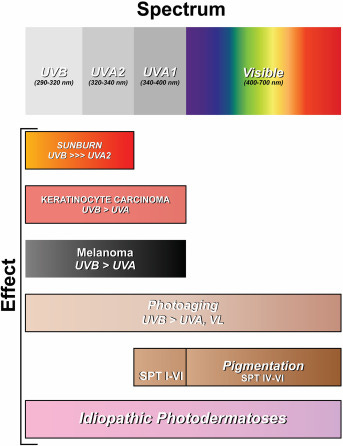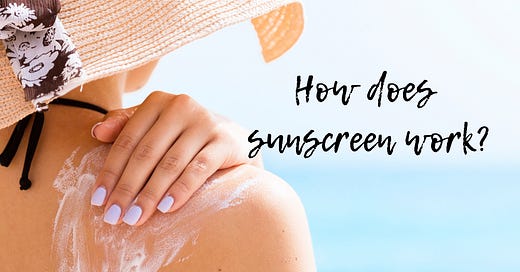How does sunscreen work?
Excessive ultraviolet radiation can damage your skin. Here's how sunscreen helps protect it.

Good morning from the (very!!) hot Mediterranean. I’m writing today from my in-laws’ house in the Basilicata province of southern Italy, and am here on vacation to visit family after a series of conferences on ethnobotany and plant metabolic engineering in Europe.
Southern Europe is experiencing a major heat wave, with temperatures of 114 F reported in Spain. In the sweltering heat, the first thing I want to do is cool off in the sea or a pool. But, that comes with risks, too—ultraviolet radiation (UVR)-induced skin damage.
I’m no stranger to the heat or sunburns. I’m fair-skinned and grew up in South Florida during the '80s and '90s, when it was trendy to slather on tanning oil and bask on lawn chairs in pursuit of a deep tan. Excessive UVR exposure can not only cause sunburns, but also damage the skin, causing photoaging, pigmentary disorders and an increased risk for skin cancers.
These days, I no longer chase that deep tan. Instead, I cover up as much as possible with a long-sleeved photoprotective shirt, a wide-brimmed hat, sunscreen, and by seeking out the shade. In today’s post, I’ll share a bit about how UVR damages the skin and how sunscreen can offer some protection.
What is UVR?
Ultraviolet radiation (UVR) is a component of sunlight that includes UVB (290–320 nm) and UVA (320–400 nm) wavelengths. UVB is the primary cause of sunburn and plays a major role in the development of skin cancer, while UVA—especially the longer UVA1 rays—contributes to photoaging, pigmentary disorders, and skin cancers. UVA also penetrates deeper into the skin and remains relatively constant year-round.

What is sunscreen?
Sunscreen is a topical product designed to protect the skin from UVR-induced damage. It contains active ingredients that either absorb or reflect harmful UV rays, and may include additives like antioxidants and iron oxides to broaden protection, especially against visible light, which can contribute to pigmentation issues. Sunscreens come in various formulations (e.g., lotions, sprays, sticks, and more) tailored to user preferences and skin types.
How does sunscreen work?
Sunscreen works by incorporating UV filters—either organic (chemical) or inorganic (physical/mineral)—that absorb, and to a lesser extent, reflect and scatter UVR. Organic filters convert UV energy into heat through their chemical structure. Inorganic filters like zinc oxide and titanium dioxide also absorb UVR, though they were once thought to act mostly by reflection. Modern formulations combine ingredients to provide broad-spectrum protection across the UVB, UVA, and even visible light ranges.
Ingredients that absorb UVR: Organic (chemical) filters absorb UVR and convert it into harmless heat. Examples include avobenzone (for UVA1 and UVA2), octinoxate, oxybenzone, octocrylene, and homosalate (primarily for UVB). These ingredients are chromophores with conjugated molecular structures that enable them to absorb specific wavelengths of UV light efficiently.
Ingredients that scatter and reflect light: Inorganic (physical) filters such as zinc oxide and titanium dioxide scatter and reflect a small portion of UVR, but primarily function by absorbing it. Micronized or nanoparticle forms reduce the white, chalky appearance on the skin, improving their cosmetic appeal while maintaining protection. Larger pigmentary particles, especially those in tinted formulations, can also enhance visible light protection through greater light scattering.

What about SPF?
You’ll notice the SPF number prominently displayed on sunscreen products, but what does this number actually mean? The SPF, or Sun Protection Factor, is a measure of how well a sunscreen protects the skin from UVB radiation, the type of ultraviolet light primarily responsible for sunburn.
In simple terms, SPF tells you how much longer you can stay in the sun without burning compared to if you weren’t wearing any sunscreen. For example, SPF 30 means it would take 30 times longer to develop sunburn than if you had no protection—assuming the product is applied correctly and generously (at 2 mg/cm² of skin).
However, in real-world conditions, most people apply much less than the recommended amount. As a result, the actual protection may be significantly lower than what’s on the label. Studies have shown that SPF 30 applied at a quarter of the recommended thickness can offer as little as SPF 9 in practice. That’s why choosing a higher SPF (like 50 or more) can provide a more reliable buffer, especially when application is imperfect.
The Takeaway
UV radiation is a powerful hazard that damages the skin in multiple ways—from sunburn and photoaging to pigment disorders and cancer. The first line of defense are physical barriers such as skin protective clothing, hat, and seeking shade. Beyond these measures, sunscreen remains a cornerstone of photoprotection. For best results, choose a broad-spectrum product with SPF 30 or higher (I use SPF 50 or 70), apply it generously and reapply regularly. Consider tinted or antioxidant-enriched formulations for added benefits, especially for individuals with skin of color or sensitivity to visible light.
Look out for my next newsletter to learn about which herbs can help to soothe the skin if you do get a sunburn.
Lastly, a quick poll! I’m gong to speaking next week along with herbalist, Raffaela Irenze, at a small community event in Ginestra, Italy on traditional Mediterranean herbs used for skin health and cosmetics. The event is in Italian, though I can work in some translation to English at it as well on the fly. Here’s the event description (also translated below):
Laboratorio “Radici di Bellezza”- L’arte antica del benessere naturale
L’Amministrazione Comunale di Ginestra è lieta di regalarti un viaggio sensoriale tra memoria e tradizioni, per ritrovare armonia attraverso la semplicità dei rituali antichi, tramandati nel tempo dalle sapienti mani femminili. Tra erbe profumate, oli, unguenti e piccoli gesti quotidiani, potrai riscoprire il legame profondo con la terra e lasciarti guidare in un’esperienza autentica di benessere.
"Roots of Beauty" Laboratory – The Ancient Art of Natural Wellness
The Municipal Administration of Ginestra is pleased to offer you a sensory journey through memory and tradition, to rediscover harmony through the simplicity of ancient rituals passed down over time by the skilled hands of women. Among fragrant herbs, oils, ointments, and small daily gestures, you’ll have the chance to reconnect deeply with the land and be guided through an authentic experience of wellness.
How many of you would be interested in watching if I offer a live stream? It starts at 6 PM Italian time (noon EST/9 AM PT) on Thursday, July 10.
Yours in health, Dr. Quave
Cassandra L. Quave, Ph.D. is a Guggenheim Fellow, CNN Champion for Change, Fellow of the National Academy of Inventors, recipient of The National Academies Award for Excellence in Science Communication, and award-winning author of The Plant Hunter. Her day job is as professor and herbarium director at Emory University School of Medicine, where she leads a group of research scientists studying medicinal plants to find new life-saving drugs from nature. She hosts the Foodie Pharmacology podcast and writes the Nature’s Pharmacy newsletter to share the science behind natural medicines. To support her effort, consider a paid or founding subscription to Nature’s Pharmacy or donation to her lab research.
The Plant Hunter is available in hardcover, paperback, audio, and e-book formats!






I can't help asking what pharmaceutical sunscreen (apply generously and reapply regularly!) has anything to do with Natures Pharmacy?